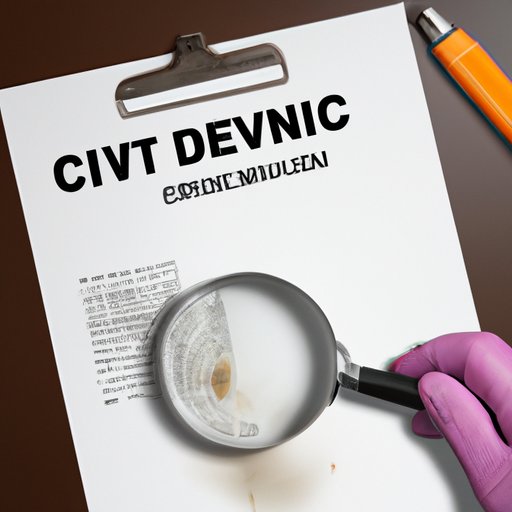Introduction
In a legal setting, evidence is used to prove or disprove a fact in a case. There are two primary types of evidence: direct evidence and circumstantial evidence. Direct evidence can be used to establish a link between an accused person and a crime. On the other hand, circumstantial evidence is used to infer that a certain conclusion is true. In this article, we’ll explore what is circumstantial evidence in forensic science and its role in criminal investigations and court cases.

Analyzing the Value of Circumstantial Evidence in Criminal Investigations
Circumstantial evidence can be used to establish links in a case, even when there is no direct proof. For example, a suspect’s fingerprints on a weapon could be used as circumstantial evidence that the suspect was at the scene of a crime. According to an article published in the International Journal of Legal Medicine, “The main purpose of circumstantial evidence is to support the hypothesis that the accused has committed the offence.”
The benefit of using circumstantial evidence in criminal investigations is that it can help to build a stronger case against a suspect. This is especially useful in cases where there is no direct evidence available. Additionally, circumstantial evidence can help to corroborate other evidence, such as witness testimony or physical evidence. By combining different pieces of circumstantial evidence, investigators can build a more complete picture of what happened.

Examining the Effectiveness of Circumstantial Evidence in Court Cases
When it comes to court cases, it’s important to understand the different types of circumstantial evidence and how they can be used. Common types of circumstantial evidence include motive, opportunity, intent, and identity. Motive evidence shows why a person might have committed a crime, while opportunity evidence indicates that the suspect had the opportunity to commit the crime. Intent evidence suggests that the suspect intended to commit the crime, and identity evidence establishes a link between the suspect and the crime.
When evaluating the strength of circumstantial evidence in court, it’s important to consider how reliable the evidence is. The more reliable the evidence, the more likely it is to be accepted by the court. Additionally, the weight of the evidence should be considered. If the evidence is weak, it may not be enough to prove a case.
Investigating How Circumstantial Evidence is Collected and Presented in Court
When collecting and presenting circumstantial evidence in court, it’s important to follow the correct process. First, investigators must collect all relevant evidence, including both direct and circumstantial evidence. This evidence is then examined and analyzed to determine if it is sufficient to prove a case. Once this is done, the evidence is presented to the court in a clear and concise manner.
One of the challenges of using circumstantial evidence in court is that it can be difficult to establish a connection between the evidence and a suspect. Additionally, circumstantial evidence can be open to interpretation, which makes it difficult to prove a case beyond a reasonable doubt. As such, it’s important to present the evidence in a way that makes it clear how it supports the argument being made.

Comparing Direct and Circumstantial Evidence in Forensic Science
It’s important to understand the difference between direct and circumstantial evidence in forensic science. Direct evidence is evidence that directly proves a fact, such as a confession or fingerprint. On the other hand, circumstantial evidence is used to infer a fact, such as a suspect’s whereabouts at the time of a crime.
Direct evidence is generally considered to be more reliable than circumstantial evidence, as it is harder to dispute. However, circumstantial evidence can still be valuable in proving a case. Additionally, circumstantial evidence can be used to corroborate direct evidence, making it a powerful tool in criminal investigations.
Investigating the Use of Circumstantial Evidence in Cold Cases
Cold cases are unsolved crimes that have gone cold due to lack of evidence. While direct evidence may be difficult to come by in these cases, circumstantial evidence can still be used to help solve them. In some cases, circumstantial evidence may be the only way to establish a link between a suspect and a crime.
For example, a suspect’s DNA found at the scene of a crime could be used as circumstantial evidence in a cold case. Additionally, circumstantial evidence can be used to corroborate other evidence, such as witness testimony or physical evidence. By combining different pieces of circumstantial evidence, investigators can build a more complete picture of what happened.
Conclusion
In conclusion, circumstantial evidence plays an important role in forensic science. It can be used to establish links in a case, even when there is no direct evidence available. Additionally, it can be used to corroborate other evidence, such as witness testimony or physical evidence. When evaluating the strength of circumstantial evidence in court, it’s important to consider how reliable the evidence is and the weight of the evidence. Finally, circumstantial evidence can be used to help solve cold cases, as it can be used to establish a link between a suspect and a crime.
(Note: Is this article not meeting your expectations? Do you have knowledge or insights to share? Unlock new opportunities and expand your reach by joining our authors team. Click Registration to join us and share your expertise with our readers.)
